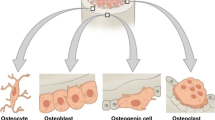Abstract
The quality of cryosections prepared from high pressure frozen bovine articular cartilage has been recently evaluated by systematic electron diffraction analysis, and vitrification found to be zone-dependent. The lower radial layer was optimally frozen throughout the entire section thickness (150 μm), whereas in the upper radial, transitional and superficial layers this was achieved down to a depth of only approximately 5–50 μm. These differences were found to correlate proportionally with proteoglycan concentration and inversely with water content. In the current investigation, extracellular matrix ultrastructure was examined in high pressure frozen material (derived from the lower radial zone of young adult bovine articular cartilage), by both cryoelectron microscopy of cryosections and by conventional transmission electron microscopy of freeze-substituted and embedded samples. Several novel features were revealed, in particular, the existence of a fine filamentous network; this consisted of elements 10–15 nm in diameter and with a regular cross-banded structure similar to that characterising collagen fibrils. These filaments were encountered throughout the entire extracellular space, even within the pericellular region, which is generally believed to be free of filamentous or fibrillar components. The proteoglycan-rich interfibrillar/filamentous space manifested a fine granular appearance, there being no evidence of the reticular network previously seen in suboptimally frozen material.
Similar content being viewed by others
References
Arsenault AL, Kohler DM (1994) Image analysis of the extracellular matrix. Microsc Res Tech 28:409–421
Dahl R, Staehelin A (1989) High-pressure freezing for the preservation of biological structure: theory and practice. J Electron Microsc Tech 13:165–174
Dubochet J, Adrian M, Chang JJ, Homo JC, Lepault J, McDowall AW (1988) Cryoelectron microscopy of vitrified specimens. Q Rev Biophys 21/2:129–228
Eggli PS, Herrmann W, Hunziker EB, Schenk RK (1985) Matrix compartments in the growth plate of the proximal tibia of rats. Anat Rec 211:246–257
Engfeldt B, Hjertquist SO (1968) Studies on the epiphysial growth zone. I. The preservation of acid glycosaminoglycans in tissues in some histotechnical procedures for electron microscopy. Virchows Arch 1:222–229
Engfeldt B, Reinholt FP, Hultenby K, Widholm SM, Muller M (1994) Ultrastructure of hypertrophic cartilage: histochemical procedures compared with high pressure freezing and freeze substitution. Calcif Tissue Int 55:274–280
Freeman MAR (1973) Adult articular cartilage. Pitman Medical, London
Ghadially FN (1983) Fine structure of synovial joints. A text and atlas of the ultrastructure of normal and pathological articular tissues. Butterworth, London
Hunziker EB (1993) Application of cryotechniques in cartilage tissue preservation and immunoelectron microscopy—potentials and problems. Microsc Res Tech 24:457–464
Hunziker EB, Graber W (1986) Differential extraction of proteoglycans from cartilage tissue matrix compartments in isotonic buffer salt solutions and commercial tissue culture media. J Histochem Cytochem 34:1149–1153
Hunziker EB, Schenk RK (1984) Cartilage ultrastructure after high pressure freezing, freeze-substitution, and low temperature embedding. II. Intercellular matrix ultrastructure-preservation of proteoglycans in their native state. J Cell Biol 98: 277–282
Hunziker EB, Herrmann W, Schenk RK, Muller M, Moor H (1984) Cartilage ultrastructure after high pressure freezing. freeze substitution, and low temperature embedding. I. Chondrocyte ultrastructure—implications for the theories of mineralization and vascular invasion. J Cell Biol 98:267–276
Keene DR, McDonald K (1993) The ultrastructure of the connective tissue matrix of skin and cartilage after high pressure freezing and freeze-substitution. J Histochem Cytochem 41:1141–1153
Maroudas A, Muir H, Wingham J (1969) The correlation of fixed negative charge with glycosaminoglycan content of human articular cartilage. Biochim Biophys Acta 177:492–500
Mayer E, Astl G (1992) Limits of cryofixation as seen by Fourier transform infrared spectra of metamyoglobin azide and carbonyl hemoglobin in vitrified and freeze-concentrated aqueous solution. Ultramicroscopy 45:185–197
Michel M, Hillmann T, Muller M (1991) Cryosectioning of plant material frozen at high pressure. J Microsc 163:3–18
Michel M, Gnägi H, Muller M (1992) Diamonds are a cryosectioners best friend. J Microsc 166:43–56
Moor H (1987) Theory and practice of high pressure freezing. In: Steinbrecht RA, Zierold K (eds) Cryotechniques in biological electron microscopy. Springer, Heidelberg, New York, Berlin, pp 175–191
Muller M, Moor H (1984) Cryofixation of thick specimens by high pressure freezing. In: Reveal JP, Barnard T, Haggis GH (eds) The science of biological specimen preparation. SEM, AMF O'Hare, Chicago, pp 131–138
Sitte H, Edelmann L, Neumann K (1987) Cryofixation without pretreatment at ambient pressure. In: Steinbrecht RA, Zierold K (eds) Cryotechniques in biological electron microscopy. Springer, Berlin Heidelberg New York, pp 87–114
Steinbrecht RA, Muller M (1987) Freeze-substitution and freezedrying. In: Steinbrecht RA, Zierold K (eds) Cryotechniques in biological electron microscopy. Springer, Berlin Heidelberg New York, pp 149–172
Stockwell RA (1979) Biology of cartilage cells. Cambridge University Press, Cambridge
Studer D, Michel M, Muller M (1989) High pressure freezing comes of age. Scanning Microsc [Suppl] 3:253–269
Studer D, Michel M, Wohlwend M, Hunziker EB, Buschmann M (1995) Vitrification of articular cartilage by high pressure freezing. J Microsc 179:321–332
Studer D, Chiquet M, Hunziker EB (1996) Evidence for a distinct water rich layer surrounding collagen II fibrils in articular cartilage extracellular matrix. J Struct Biol (in press)
Weiss C, Rosenberg L, Helfet AJ (1968) An ultrastructural study of normal young adult human articular cartilage. J Bone Joint Surg [Am] 50:663–674
Author information
Authors and Affiliations
Rights and permissions
About this article
Cite this article
Hunziker, E.B., Wagner, J. & Studer, D. Vitrified articular cartilage reveals novel ultra-structural features respecting extracellular matrix architecture. Histochem Cell Biol 106, 375–382 (1996). https://doi.org/10.1007/BF02473296
Accepted:
Issue Date:
DOI: https://doi.org/10.1007/BF02473296




